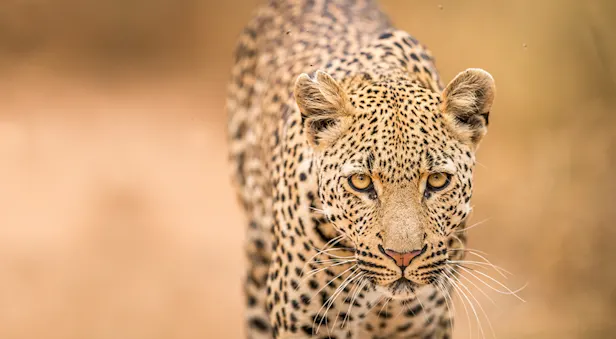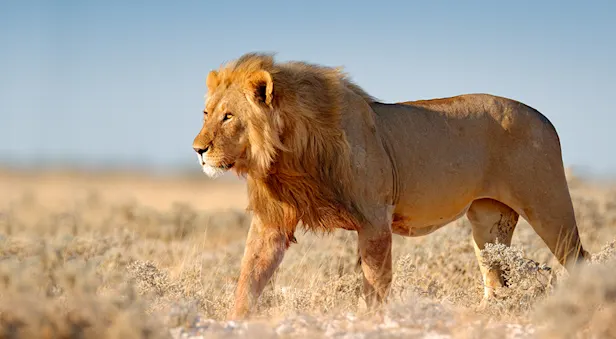Know Before You Go
Wildebeest Facts | Southern Africa Wildlife Guide
Physical Characteristics
The wildebeest, also known as the gnu, is a large antelope measuring between 45 and 55 inches at the shoulder and weighing between 300 and 600 pounds.
Wildebeests measure between 5 and 8 feet in length and have a tail length of 14 to 22 inches.
When the Dutch settled in South Africa, they named this animal “wildebeest,” meaning “wild beast,” due to its untamed appearance and vigorous nature.
Wildebeests have a long, rectangular-shaped head.
Both males and females possess lengthy horns that spring outward from the base of their head and form curved semicircles, pointing slightly backward.
In adult males, the horns are heavily embossed.
The different subspecies of the wildebeest vary in color, ranging from slate gray to dark brown, with males darker than females.
All wildebeests have short hair covering their bodies, with black vertical stripes of longer hair on their back.
The body of a wildebeest appears disproportionate, with a hefty front, slim hindquarters, and spindly legs.
Habitat & Feeding Habits
Wildebeest thrive in areas that are neither too wet nor too dry, with their range extending from the equator to the tip of South Africa. The blue wildebeest, known as the brindled gnu, ranges from Kenya to northern South Africa. They prefer the dense bushlands, open grasslands and woodland floodplains of the southern savanna.
Wildebeests are strictly grazers, preferring sweet, stocky grasses. This grass often grows in areas that have seen recent fire, as tall, coarse brush is burnt, permitting room for new vegetation to grow. Wildebeest will also follow herds of other grazers that eat dry, longer grasses. In addition to grasses, these creatures also eat succulent plants and browse on karoo bushes. They begin grazing soon after sunrise, rest briefly at midday, and continue feeding until sunset. Wildebeest need water almost daily.
Behavior
Wildebeest are sociable, territorial animals. Females and their young form small herds, their territories frequently overlapping. After about a year, males will leave their herd and enter into a bachelor herd. At 4 or 5 years old, males will become highly territorial and depart from the bachelor herd. Cow and calf herds typically remain constant; however, when there are many groups clustered close together in an area, cows will often leave their group for another.
Neighboring bulls will challenge one another when encountering each other at the edges of their territories. They follow a series of ritualized actions: bucking, snorting, pawing at the ground, fighting, and grunting in a deep croaking manner like a frog. The wildebeests will face one another on their knees, foreheads to the ground, ready for combat. The bulls move forward to strike each other, knocking heads and horns, but rarely will become injured. Some scientists speculate that these confrontations spark a rise in hormone levels, as non-territorial bulls in bachelor groups are very serene.
Wildebeest are constantly moving throughout day and night, in search of water and preferred grasses. They tend to migrate in lengthy, single-file columns, traversing long distances at an easy rocking gallop, though they are swift when provoked. Animals such as Thomson’s gazelle, zebra, and even predators will follow the traveling wildebeest. The number of times a herd moves and the number of females in a herd depends on a number of environmental factors, such as quantity of rainfall or quality of dry season pasture.
The Migration
Each year, wildebeest in the Serengeti-Mara travel in a migratory circle of 500 to 1,000 miles. After calves are born in January and February, the migration begins in the southeastern Serengeti. Traversing across the short-grass plains, wildebeest approach Lake Victoria in the west. They head toward open woodland, then curve north en route for the Mara. Lastly, they take a turn to the south toward home. They are single-minded in their pursuit, swimming across bodies of water in such massive numbers that many die, become injured, or are lost (particularly calves).
Predators
Wildebeest are highly desirable prey for spotted hyena and lion. Although wildebeest are unable to adequately camouflage themselves, they are afforded some protection by gathering in large herds.
Reproduction
The beginning of the mating season, called the rut, is connected to the full moon. Territorial males, however, are constantly prepared to mate. Throughout the mating season, breeding clusters of around 150 wildebeest form from within the bigger herds. In these groupings, five or six of the most dominant bulls create and guard territories that cows amble through. Bulls make a show of bucking and cantering around their lands. Bulls also mark their territories by urinating, defecating and spreading secretions in particular areas. The secretions come from the interdigital and preorbital glands, spread when bulls paw at the ground and proceed to rub it with their heads.
When a bull comes into contact with another wildebeest, they acknowledge one another by moving at a rocking canter. If they are greeting a cow, the bull will attempt to mount or herd her. If the cow is calm, the bull will repeatedly mate with her about two times per minute. If her herd is mobile, a cow may come across several dozen bulls a day. If she is in full heat, a bull will always be close to her side.
During the mating season, wildebeest are quite a bit more riled—herding, fighting, and calling to each other frequently. An aroused bull will try to herd as many cows as possible, and will not sleep or eat for excitement if a female is nearby. Females typically reach sexual maturity at 16 months, though they frequently do not mate until around 28 months old. Cows are extremely fertile, conceiving at a high rate, in part because the peak of their breeding season is at the end of the rainy season, anticipating a fair climate for carrying offspring. Gestation is 8 to 8.5 months. Wildebeest are unique from other African animals in that they calve within the same short span of time, during the month before or start of peak rainy season.
Female wildebeest give birth to one calf in the center of the herd, rather than finding an isolated place, as many antelope species do. Astoundingly, around 80 percent of females in a herd give birth within the same two to three weeks. The overabundance of calves allows for more of them to survive predation in the first vulnerable weeks of their lives. Once a calf is delivered, the mother begins to lick it. After six minutes, the calf is able to stand on its feet and attempts to be nursed. It is very important that the mother stays close to her newborn for the first two days in order to assure that the calf imprints on its mother, which begins with the first suckling.
Newborns are a yellowish-brown, but change to adult color at about 2 months. A calf suckles from its mother for at least four months, though it begins eating grass after about 10 days. A calf will stay with its mother, even after it is weaned, until the next year’s newborn arrives. Young females usually remain in the same herds as their mothers, while males are sent away. At 8 months, the young leave their mothers and form peer groups. Photo Credit: Thuto Moutloatse


























